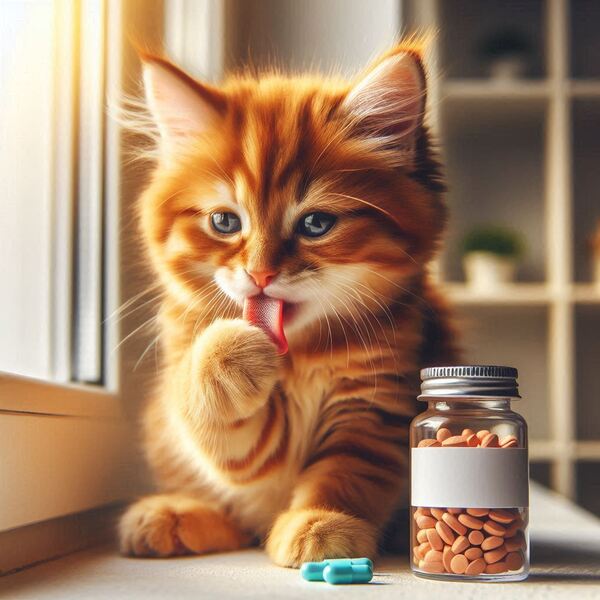Gabapentin is a medication that is commonly used to manage pain and certain neurological conditions in both humans and animals, including cats. If your cat is suffering from chronic pain, seizures, or anxiety, your veterinarian may recommend gabapentin as part of their treatment plan. However, understanding the correct dose for your cat is crucial for its safety and effectiveness. In this article, we’ll explain how gabapentin works, the appropriate dosage for cats, and some important considerations to keep in mind.

Gabapentin is a medication that was initially developed to treat seizures and neuropathic pain in humans. It works by affecting the way nerves transmit pain signals to the brain, which can be especially helpful for conditions like arthritis, nerve damage, and certain types of anxiety. In cats, gabapentin is frequently prescribed for:
Pain management: For conditions like arthritis, injuries, or post-surgical recovery.
Seizure control: In cases of epilepsy or other seizure disorders.
Anxiety: Gabapentin can help calm cats during stressful situations such as vet visits or travel.
Neurological disorders: It can also help manage pain from conditions like intervertebral disc disease (IVDD).
The appropriate dose of gabapentin for cats will vary depending on the specific condition being treated, the size of your cat, and how they respond to the medication. However, in general, the typical dosage range for cats is as follows:
Pain management: 1-2 mg per pound (2.2-4.5 mg per kilogram) every 8 to 12 hours.
Seizure control: 5-10 mg per pound (10-20 mg per kilogram) every 8 to 12 hours.
Anxiety or stress: 1-2 mg per pound (2.2-4.5 mg per kilogram) 1 to 2 hours before the stressful event, such as a vet visit or travel.
Gabapentin is typically available in capsule or liquid form. If your cat is difficult to pill, your veterinarian may recommend the liquid form, which can be easier to administer. Gabapentin should always be given exactly as prescribed by your vet. If you accidentally miss a dose, follow the instructions given by your vet for how to proceed—never double a dose to make up for a missed one.

While gabapentin can be an effective treatment for many conditions, there are several important things to consider when giving it to your cat:
When starting gabapentin, your veterinarian may recommend starting with a lower dose and gradually increasing it. This approach can help reduce the risk of side effects and allow your vet to monitor how your cat is responding to the medication.
While gabapentin is generally well-tolerated by cats, there are potential side effects, including:
Drowsiness or sedation: This is the most common side effect. It’s normal for gabapentin to make your cat a bit sleepy or relaxed, especially when starting the medication. However, if your cat becomes excessively lethargic or uncoordinated, contact your vet.
Vomiting or loss of appetite: Some cats may experience gastrointestinal upset when taking gabapentin.
Behavioral changes: Rarely, gabapentin can cause behavioral changes, such as increased anxiety or aggression.
Gabapentin may not be suitable for cats with certain health conditions, such as kidney disease, so it’s important to inform your vet about any pre-existing medical conditions your cat may have.
If your cat has been on gabapentin for a long period, don’t stop the medication suddenly. Doing so could lead to withdrawal symptoms, such as increased anxiety or seizures. Your vet will guide you on how to taper off the medication safely if it is no longer needed.
Gabapentin can interact with other medications your cat may be taking. Make sure to inform your vet about any other drugs, supplements, or treatments your cat is receiving to avoid potential interactions.
Although overdosing on gabapentin is rare, it’s important to be aware of the signs of an overdose, which can include:
Excessive drowsiness or lethargy
Vomiting
Tremors or shaking
Incoordination or difficulty walking
If you suspect your cat has ingested too much gabapentin, contact your veterinarian immediately or seek emergency veterinary care.
If you’re having trouble giving your cat gabapentin, here are a few tips that may help:
Pill pockets or treats: If your cat is reluctant to take pills, you can try using pill pockets or wrapping the pill in a treat.
Crushing or opening the capsule: If you’re using the capsule form of gabapentin, ask your vet if it’s safe to crush the pill or open the capsule and mix the powder with a small amount of wet food.
Positive reinforcement: Always reward your cat with praise, petting, or a favorite treat after successfully administering the medication.
Gabapentin can be a valuable tool in managing pain, anxiety, and certain neurological conditions in cats. However, it’s essential to follow the prescribed dose and monitor your cat for any adverse reactions. If you have any concerns about giving gabapentin to your cat, or if you’re unsure about the correct dosage, be sure to consult with your veterinarian. With the right dose and proper care, gabapentin can help improve your cat’s quality of life and comfort.
animal tags: cats
We created this article in conjunction with AI technology, then made sure it was fact-checked and edited by a Animals Top editor.